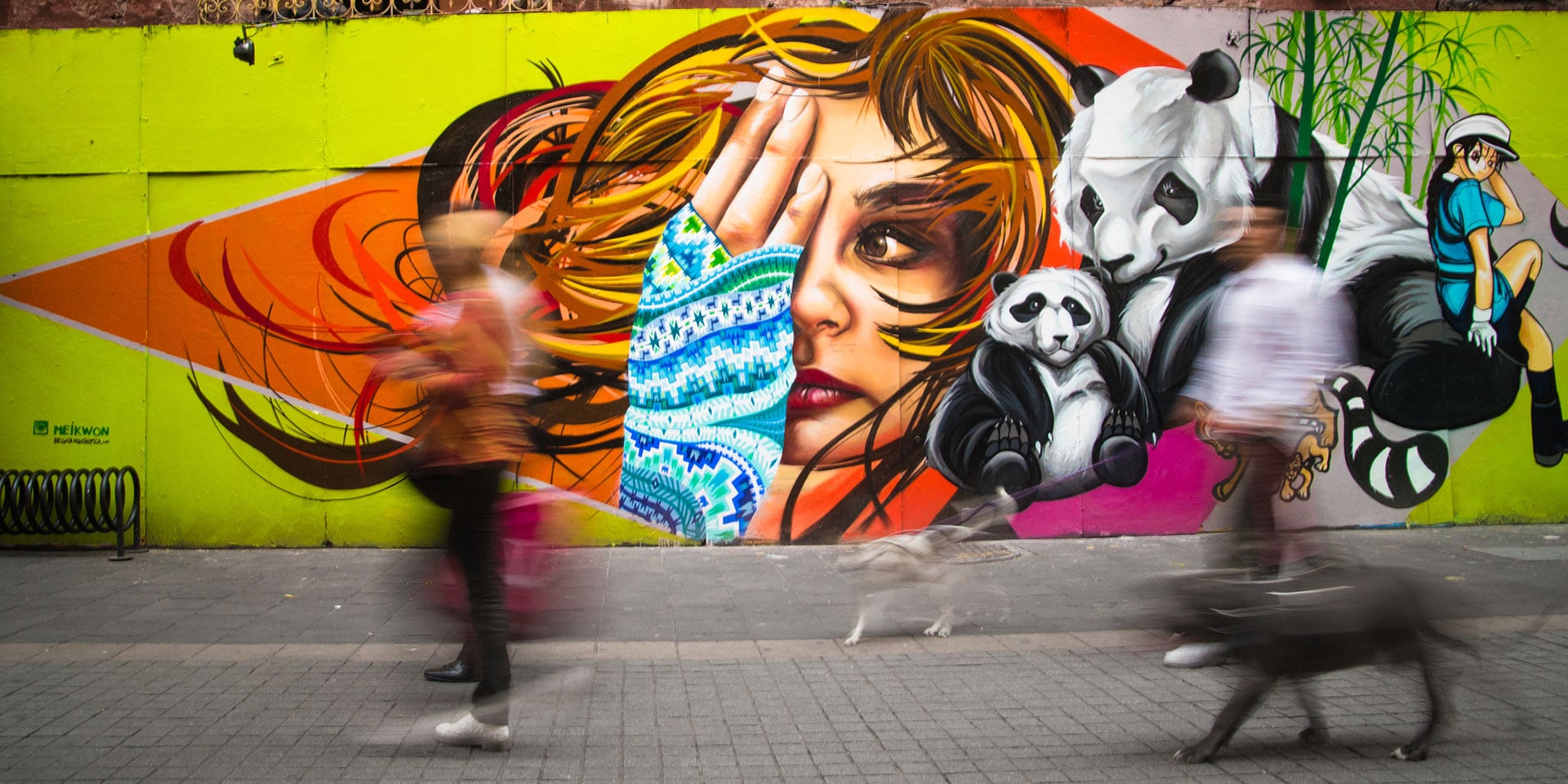So, have you ever wondered about the vibrant street art scene in Mexico? I mean, seriously. The amount of talent and creativity that you can find in the graffiti and murals in Mexican cities is just mind-blowing. And the best part? It’s all out there, waiting to be discovered. In this article, we’re going to delve into the world of Mexican street art and explore the wonders that await you in this captivating form of expression. Trust me, you’re in for a treat.
Now, let’s talk about Mexico. I mean, it’s a country known for its stunning beaches, rich culture, and of course, its delicious food. But did you know that Mexico is also home to a vibrant street art scene? Yep, you heard that right. From the bustling streets of Mexico City to the colorful neighborhoods of Oaxaca, you’ll find walls adorned with incredible murals and graffiti that truly capture the spirit of Mexico. And the best part is, you don’t need to step foot inside a gallery to experience this art. It’s all right there, on the streets, waiting for you to take it in. So buckle up, because we’re about to take a deep dive into the world of Mexican street art, and trust me, it’s going to be one heck of a journey.
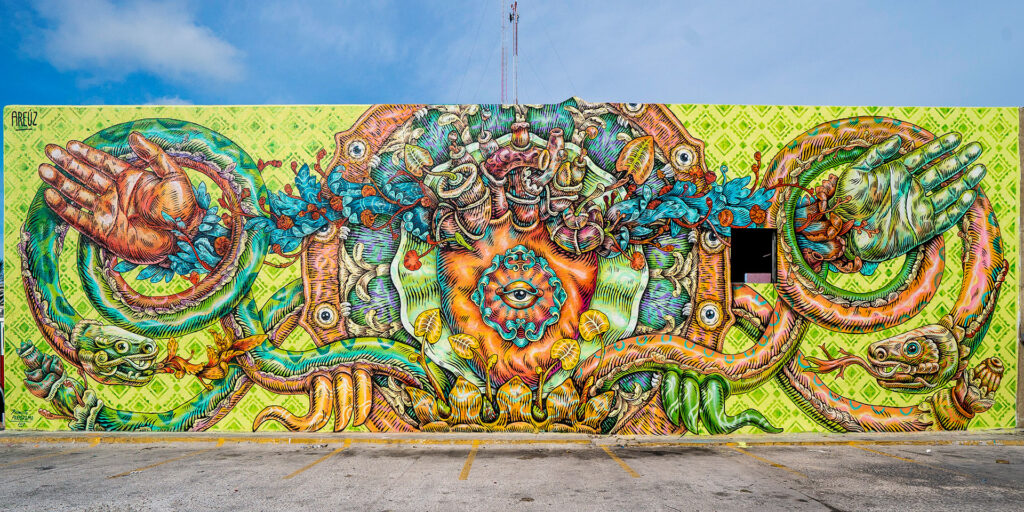
Introduction
Have you ever wandered the colorful streets of Mexico and stumbled upon incredible artworks adorning the walls? Mexican street art is a vibrant and powerful form of artistic expression that captivates audiences with its rich cultural heritage and socially impactful messages. From the bustling neighborhoods of Mexico City to the charming cities of Oaxaca and Guanajuato, the nation is a haven for street artists and enthusiasts alike. In this article, we will take a journey through the origins, evolution, styles, and techniques of Mexican street art. We’ll also explore the historical influences, prominent artists, iconic locations, festivals and events, social and cultural impact, challenges and controversies, preservation efforts, international recognition, and the exciting future of this dynamic art scene. So, grab your spray cans and let’s dive into the vibrant world of Mexican street art!
The Origins of Mexican Street Art
The roots of Mexican street art can be traced back to the pre-Hispanic era, where art played a significant role in indigenous cultures. These ancient civilizations expressed their beliefs, myths, and rituals through intricate murals and carvings. The Mexican muralist movement of the early 20th century, led by artists like Diego Rivera, David Alfaro Siqueiros, and Orozco, revived and redefined this tradition of public art. Their murals depicted the history, culture, and struggles of the Mexican people, and their work had a profound influence on the development of Mexican street art as we know it today.

The Evolution of Mexican Street Art
Mexican street art has come a long way since its humble beginnings. In the 1970s, graffiti culture from the United States began to influence Mexican artists who incorporated spray cans, tags, and graffiti lettering into their work. With time, street art in Mexico developed its own unique style, fusing elements of graffiti, muralism, and indigenous art. This fusion created a visual language that speaks to the vibrant and diverse cultural heritage of the country. Today, Mexican street art encompasses a wide range of styles and techniques, from photorealistic portraits to abstract murals bursting with color.
Styles and Techniques of Mexican Street Art
Mexican street art is a melting pot of artistic styles and techniques. Artists draw inspiration from various sources, such as traditional Mexican folk art, surrealism, pop art, and contemporary urban culture. Whether it’s the intricate detail of a mural or the energetic strokes of a graffiti piece, Mexican street art is known for its bold colors, striking imagery, and intricate patterns. Stenciling, wheat-pasting, sticker bombing, and traditional brush painting are just a few of the techniques used by Mexican street artists to bring their visions to life on the walls of cities across the country.
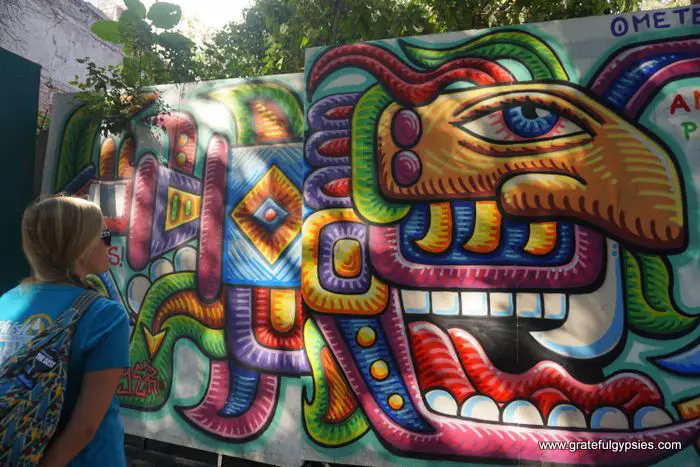
Historical Influences on Mexican Street Art
Pre-Hispanic Art Influence
The artistic traditions of indigenous civilizations, such as the Olmec, Maya, and Aztec, have had a lasting impact on Mexican street art. The intricate patterns, symbols, and motifs of pre-Hispanic art can often be seen in the works of street artists, connecting the present with the rich cultural heritage of the past. These influences not only add depth and meaning to the artwork but also serve as a reminder of Mexico’s diverse and ancient roots.
Muralism and Social Movements
The Mexican muralist movement of the early 20th century played a crucial role in shaping the direction of Mexican street art. Artists like Diego Rivera, David Alfaro Siqueiros, and Orozco used large-scale murals to convey social and political messages, advocating for social justice, worker’s rights, and indigenous rights. Their work inspired a new generation of artists who continued the tradition of using art as a tool for social change. Mexican street art often reflects the struggles and aspirations of marginalized communities, giving them a voice and raising awareness about important issues.
Political and Revolutionary Art
Mexico’s revolutionary history has also left its mark on the street art scene. The revolutionary period of the early 20th century, marked by the Mexican Revolution and the subsequent fight for social and political reform, has been a source of inspiration for many artists. Political and revolutionary art often tackles themes of rebellion, resistance, and the fight against oppression. From images of revolutionary leaders to powerful symbols of solidarity, Mexican street art pays homage to the country’s tumultuous past and its ongoing struggle for justice and equality.
Prominent Mexican Street Artists
Mexican street art has produced a plethora of talented artists, each contributing their own unique style and perspective to the scene. Here are just a few of the prominent figures who have made a significant impact:
Diego Rivera
Diego Rivera is considered one of the founding fathers of Mexican muralism and is renowned for his large-scale public artworks. His murals can be found in numerous locations throughout Mexico, telling the stories of the Mexican people and showcasing his distinctive style characterized by bold, colorful figures and intricate details. Rivera’s work continues to inspire and influence Mexican street artists to this day.
David Alfaro Siqueiros
David Alfaro Siqueiros was another key figure in the Mexican muralist movement. His murals were known for their powerful social and political messages, often depicting the struggles of the working class and indigenous communities. Siqueiros’ work pushed the boundaries of traditional muralism and had a lasting impact on Mexican street art.
Orozco
Jose Clemente Orozco was a contemporary of Rivera and Siqueiros, and his murals are renowned for their emotional intensity and intricate detail. Orozco’s work often explored themes of human suffering, revolution, and the resilience of the Mexican people. His influence on Mexican street art can be seen in the way artists continue to address these themes and evoke powerful emotions through their work.
Leonora Carrington
Although not primarily known for her street art, Leonora Carrington was a renowned surrealist artist whose work has inspired generations of Mexican artists. Her paintings often feature mythical and fantastical creatures, blurring the lines between dreams and reality. Carrington’s unique and imaginative style has had a lasting impact on the Mexican art scene, including the realm of street art.
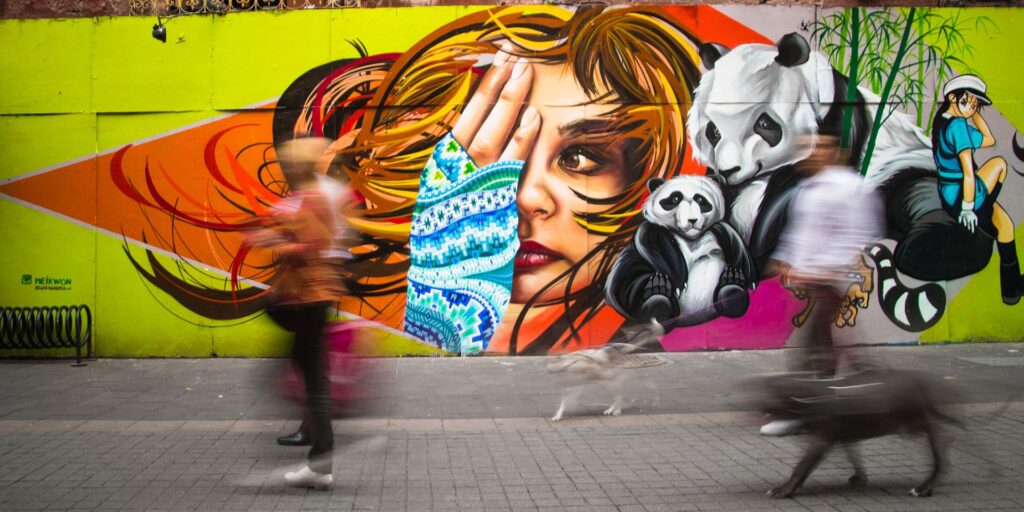
Iconic Mexican Street Art Locations
The streets of Mexico are a canvas for artists to express themselves freely, and several locations have become renowned for their vibrant street art scenes. Here are a few must-visit destinations for street art enthusiasts:
La Roma Neighborhood in Mexico City
The La Roma neighborhood in Mexico City is home to a bustling street art scene. Stroll through the streets, and you’ll be greeted by an array of colorful murals and graffiti pieces that adorn the walls. The neighborhood has become a haven for local and international artists, with its vibrant artistic community pushing the boundaries of Mexican street art.
Oaxaca City
Oaxaca City is another hotspot for street art in Mexico. The city’s rich cultural heritage blends seamlessly with contemporary street art, creating a unique artistic fusion. From colorful murals that portray the region’s indigenous traditions to thought-provoking political statements, Oaxaca City offers a diverse and visually stunning street art experience.
Guanajuato
Guanajuato, a charming colonial city in central Mexico, is known for its picturesque streets and vibrant art scene. Here, artists take full advantage of the city’s architecture, using its walls as canvases to display thought-provoking and visually captivating works of art. The narrow alleyways and colorful buildings of Guanajuato serve as the perfect backdrop for unique and immersive street art experiences.
Mexican Street Art Festivals and Events
Mexican street art festivals and events offer a platform for artists to showcase their skills, connect with the community, and celebrate the vibrant art scene. Here are a few notable festivals and events that draw art lovers from around the world:
All City Canvas
All City Canvas is one of Mexico’s largest street art festivals. It brings together local and international artists to create large-scale murals and installations across Mexico City. The festival aims to beautify public spaces, promote dialogue, and inspire social change through art.
MURO Street Art Festival
The MURO Street Art Festival takes place in the city of Monterrey and is dedicated to transforming urban spaces into open-air galleries. Local and international artists come together to paint colorful murals, creating a visual feast for residents and visitors alike. The festival not only showcases the talent of Mexican street artists but also fosters community engagement and dialogue.
Bordalo II’s Trash Animals Exhibition
Bordalo II’s Trash Animals Exhibition, held in Mexico City, uses street art as a medium to raise awareness about environmental issues. Portuguese artist Bordalo II creates large-scale installations made from recycled materials, highlighting the impact of human consumption on the natural world. This thought-provoking exhibition challenges viewers to reconsider their relationship with the environment and the importance of sustainability.
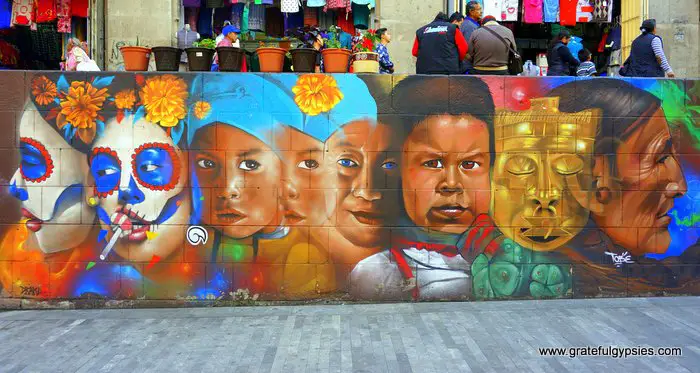
Social and Cultural Impact of Mexican Street Art
Mexican street art goes beyond aesthetics; it has a profound social and cultural impact on communities and society as a whole. Here are a few ways in which Mexican street art influences and shapes the world around it:
Expression of Identity and Pride
Mexican street art serves as a powerful means of expressing identity and cultural pride. Through their artwork, artists celebrate their heritage, traditions, and local customs, reinforcing a sense of belonging and unity within communities. The bold colors, symbols, and imagery of Mexican street art are a visual representation of the country’s rich cultural tapestry and diverse population.
Promotion of Social Justice and Activism
Mexican street art often addresses pressing social issues and challenges the status quo. Artists use their work to raise awareness about inequality, poverty, corruption, and human rights violations. Street art acts as a form of protest, giving a voice to the marginalized and demanding justice and change. The power of street art lies in its ability to engage and provoke conversations about important social and political issues.
Challenges and Controversies in Mexican Street Art
While Mexican street art is celebrated and appreciated by many, it also faces challenges and controversies. Here are a few that the art form grapples with:
Legal Issues and Graffiti
Despite its growing popularity, street art is often viewed as graffiti and illegal in many parts of Mexico. Artists face the risk of fines, arrest, or having their work removed by authorities. Balancing artistic freedom with legal boundaries remains a challenge, and the tension between the two continues to shape the landscape of Mexican street art.
Commercialization and Appropriation
As street art gains popularity, it has also become a target for commercialization and appropriation. Advertisers and brands often appropriate street art to sell products or promote their own image, diluting its original message and purpose. The commercialization of street art raises questions about authenticity, ethics, and the commercial viability of an art form rooted in public spaces.
Censorship and Removal
Street art is ephemeral by nature, and its removal and censorship are common occurrences. Public officials or property owners often deem certain artworks offensive, controversial, or in violation of regulations, leading to their removal or destruction. The loss of these works raises questions about censorship, freedom of expression, and the preservation of cultural heritage.
Preservation and Conservation Efforts
Efforts are underway to preserve and conserve Mexican street art, ensuring its longevity and accessibility for future generations. Here are a couple of initiatives that aim to safeguard and promote this unique art form:
Community Initiatives
Local communities play a vital role in preserving and promoting street art. Residents in some neighborhoods have formed collectives and organizations dedicated to preserving the artworks in their communities. They work closely with artists, ensuring proper maintenance, restoration when necessary, and educating the public about the cultural and historical significance of Mexican street art.
Mural Restoration Projects
Many cities in Mexico have recognized the importance of preserving street art and invested in mural restoration projects. These projects involve collaborations between artists, conservationists, and community organizations to repair, preserve, and, in some cases, relocate artworks to ensure their long-term survival. Mural restoration projects not only protect the physical integrity of the artworks but also contribute to the cultural and aesthetic vibrancy of the cities.
International Recognition and Influence
Mexican street art has gained international recognition and influenced artists worldwide. Here are a couple of ways in which it has made its mark beyond Mexico’s borders:
Global Street Art Documentaries
Documentaries such as “Walls of Passion” and “Here Comes the Neighborhood” have shed light on the vibrant Mexican street art scene. These films explore the history, artists, and social impact of Mexican street art, bringing the art form to a global audience and inspiring artists around the world.
Exhibitions and Collaborations with International Artists
The international art community has increasingly recognized the talent and creativity of Mexican street artists. Exhibitions and collaborations with international artists provide an opportunity for cultural exchange, fostering dialogue, and inspiring new approaches to street art. Mexican street artists have participated in exhibitions and street art festivals in countries around the world, contributing to the global street art movement.
The Future of Mexican Street Art
The future of Mexican street art is bright and full of exciting possibilities. Here are a couple of trends and developments that we can expect to see in the coming years:
Pushing Boundaries and Experimentation
Mexican street artists continue to push boundaries and experiment with new styles, techniques, and mediums. From incorporating technology such as augmented reality and interactive elements into their work to exploring new ways of engaging with the public, artists are constantly pushing the limits of what street art can be.
Integration of Technology and Street Art
The integration of technology into street art is becoming increasingly prevalent. Artists are using digital tools, projections, and interactive installations to create immersive experiences that blur the lines between the physical and virtual worlds. This fusion of art and technology opens up new avenues for artistic expression and audience engagement.
Conclusion
Mexican street art is a dynamic and thriving art form that continues to captivate audiences with its vibrant colors, powerful messages, and rich cultural heritage. From its origins in the ancient murals of pre-Hispanic civilizations to the social and political commentary of the muralist movement, Mexican street art has evolved into a distinct and influential art form. Through festivals, events, community initiatives, and international recognition, Mexican street art has gained a global reputation for its creativity, resilience, and impact on the art world. As it continues to adapt, evolve, and push boundaries, the future of Mexican street art holds exciting possibilities and promises to captivate and inspire audiences for years to come. Mexico tourism Mexico travel Mexico hotels Mexico attractions Mexico beaches
